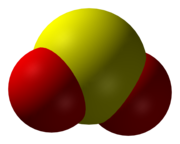
Back Swaweldioksied Afrikaans Schwefeldioxid ALS ثنائي أكسيد الكبريت Arabic Kükürd qazından təmizlənmə üsulları Azerbaijani قوقرد دیاوکسید AZB Серен диоксид Bulgarian सल्फर डाइऑक्साइड Bihari সালফার ডাইঅক্সাইড Bengali/Bangla Sumpor-dioksid BS Diòxid de sofre Catalan

| |

| |

| |
| Names | |
|---|---|
| IUPAC name
Sulfur dioxide
| |
Other names
| |
| Identifiers | |
3D model (JSmol)
|
|
| 3535237 | |
| ChEBI | |
| ChEMBL | |
| ChemSpider | |
| ECHA InfoCard | 100.028.359 |
| EC Number |
|
| E number | E220 (preservatives) |
| 1443 | |
| KEGG | |
| MeSH | Sulfur+dioxide |
PubChem CID
|
|
| RTECS number |
|
| UNII | |
| UN number | 1079, 2037 |
CompTox Dashboard (EPA)
|
|
| |
| |
| Properties | |
| SO 2 | |
| Molar mass | 64.066 g/mol |
| Appearance | Colorless and pungent gas |
| Odor | Pungent; similar to a just-struck match[1] |
| Density | 2.619 kg m−3[2] |
| Melting point | −72 °C; −98 °F; 201 K |
| Boiling point | −10 °C (14 °F; 263 K) |
| 94 g/L[3] forms sulfurous acid | |
| Vapor pressure | 230 kPa at 10 °C; 330 kPa at 20 °C; 462 kPa at 30 °C; 630 kPa at 40 °C[4] |
| Acidity (pKa) | ~1.81 |
| Basicity (pKb) | ~12.19 |
| −18.2·10−6 cm3/mol | |
| Viscosity | 12.82 μPa·s[5] |
| Structure | |
| C2v | |
| Digonal | |
| Dihedral | |
| 1.62 D | |
| Thermochemistry | |
Std molar
entropy (S⦵298) |
248.223 J K−1 mol−1 |
Std enthalpy of
formation (ΔfH⦵298) |
−296.81 kJ mol−1 |
| Hazards | |
| GHS labelling: | |
 
| |
| Danger | |
| H314, H331[6] | |
| NFPA 704 (fire diamond) | |
| Lethal dose or concentration (LD, LC): | |
LC50 (median concentration)
|
3000 ppm (mouse, 30 min) 2520 ppm (rat, 1 hr)[8] |
LCLo (lowest published)
|
993 ppm (rat, 20 min) 611 ppm (rat, 5 hr) 764 ppm (mouse, 20 min) 1000 ppm (human, 10 min) 3000 ppm (human, 5 min)[8] |
| NIOSH (US health exposure limits): | |
PEL (Permissible)
|
TWA 5 ppm (13 mg/m3)[7] |
REL (Recommended)
|
TWA 2 ppm (5 mg/m3) ST 5 ppm (13 mg/m3)[7] |
IDLH (Immediate danger)
|
100 ppm[7] |
| Related compounds | |
| Sulfur monoxide Sulfur trioxide Disulfur monoxide | |
Related compounds
|
Ozone Selenium dioxide |
Except where otherwise noted, data are given for materials in their standard state (at 25 °C [77 °F], 100 kPa).
| |
Sulfur dioxide (IUPAC-recommended spelling) or sulphur dioxide (traditional Commonwealth English) is the chemical compound with the formula SO
2. It is a toxic gas responsible for the odor of burnt matches. It is released naturally by volcanic activity and is produced as a by-product of copper extraction and the burning of sulfur-bearing fossil fuels.[9] It was known to alchemists as "volatile spirit of sulfur" since at least 16th century.[10]
- ^ Sulfur dioxide Archived 2019-12-30 at the Wayback Machine, U.S. National Library of Medicine
- ^ "Sulfur Dioxide". Archived from the original on 2023-09-24. Retrieved 2024-03-22., U.S. National Library of Medicine
- ^ Lide DR, ed. (2006). CRC Handbook of Chemistry and Physics (87th ed.). Boca Raton, FL: CRC Press. ISBN 0-8493-0487-3.
- ^ "Hazardous Substances Data Bank".
- ^ Miller J Jr, Shah P, Yaws C (1976). "Correlation constants for chemical compounds". Chemical Engineering. 83 (25): 153–180. ISSN 0009-2460.
- ^ "C&L Inventory".
- ^ a b c NIOSH Pocket Guide to Chemical Hazards. "#0575". National Institute for Occupational Safety and Health (NIOSH).
- ^ a b "Sulfur dioxide". Immediately Dangerous to Life or Health Concentrations (IDLH). National Institute for Occupational Safety and Health (NIOSH).
- ^ Cite error: The named reference
Greenwoodwas invoked but never defined (see the help page). - ^ Wothers P (2019). Antimony, Gold, and Jupiter's Wolf: How the Elements Were Named. Oxford University Press. ISBN 978-0-19-965272-3.
© MMXXIII Rich X Search. We shall prevail. All rights reserved. Rich X Search
